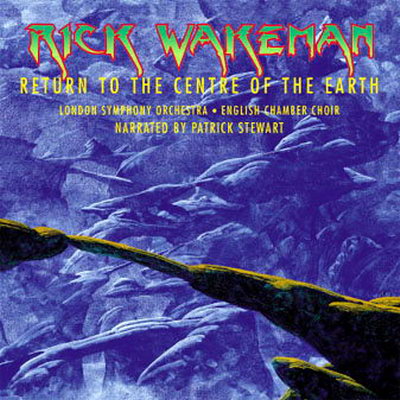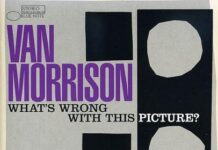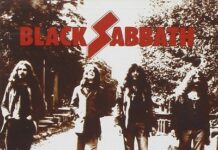Over a half-century later, Rick Wakeman continues to slog it out as one of the preeminent keyboardists in rock — notably as an off and on member of Yes. Along with ELP’s Keith Emerson and Deep Purple’s Jon Lord, Wakeman brought the keyboards to the frontline of the band — often out-soloing guitarist Steve Howe while throwing in dashes of classical and jazz just to show how well schooled he was.
As Emerson and Lord barely stray away from the confines of their respective group situations, Wakeman has continually forged ahead — composing full conceptual pieces in which his keyboard navigates makeshift ensembles of rock players around full-blown orchestras and choirs. During the early 70s, Wakeman lodged these musical experimentations with classic allegory. With historical accuracy, he boldly released The Six Wives Of Henry VIII and The Myths & Legends Of King Arthur And The Knights Of The Round Table. His most well-received album, however, was based and titled after the classic Jules Verne tale — Journey To The Centre Of The Earth.
In and around 1974, pretentious, theme-oriented albums were becoming the norm. Jethro Tull (A Passion Play, Thick As A Brick), The Who (Tommy, Quadrophenia), Pink Floyd (The Dark Side Of The Moon), Genesis (The Lamb Lies Down On Broadway), even Wakeman’s present band, Yes (Tales From Topographic Oceans) — had all been stirring up the conceptual fire with a measurable amount of success. Rick Wakeman —brandishing his infamous sparkle-covered cape — decided to up the ante with Journey.
To begin, he brought in The London Symphony Orchestra and The English Chamber Choir. Then he patched together a group of session players and singers. To give Journeya more cerebral slant he threw in a narrator by the name of David Hemmings to read passages in a manner in which the listener became part of the journey. To make it even more ambitious, he performed and recorded the album “live” before an audience.
It was pretty much downhill from there. Progressive, classically-charged rock outraged the critics, and gave way to a roots revolution in the form of punk, heavy metal and an R&B strain called disco. Wakeman and his ilk had to either conform or retire. With occasional resurfacings, he would never eclipse the artistic satisfaction or commercial success of Journey.
Mor recently, many of the great conceptual works of the 70s have re-emerged. Tommy, Quadrophenia, The Dark Side Of The Moon and The Wall have all been submitted to various treatments. Technical advances in video, audio and instrumentation have made the idea of recreating such monstrosities far easier. This, along with a desire to possibly regain his momentum, is what has apparently driven Rick Wakeman to Return To The Centre Of The Earth.
For almost 77 minutes, Wakeman pulls out every trick in the book. Once again, he procures the services of The London Symphony Orchestra and The English Chamber Choir. He employs a backing band of virtual unknowns. This time, however, Wakeman peppers his piece with a few big names. Guest vocalists include Trevor Rabin (Yes), Justin Hayward (Moody Blues), Bonnie Tyler, Katrina Leskanich (Katrina and The Waves) and Ozzy Osbourne. Reading the passages this time — with infectious precision — is Patrick Stewart, best known as Captain Jean-Luc Picard of Star Trek: The Next Generation.
Contained within the elaborate gatefold packaging by longtime Yes artist Roger Dean, Returnopens up with a pattern of lush orchestrations, slyly garnishing Stewart’s poignant articulations throughout. Utilizing a number of computerized gadgets and tools, the keyboards are seemingly shrouded — certainly not as distinctive as Wakeman’s sound can be. It isn’t until the fourth track — “Buried Alive” — that Return sonically surges forward. Ozzy Osbourne’s vocals swim effortlessly through The London Symphony’s framework. Wakeman unleashes one of his trademark solos during the song’s mounting crescendo.
From here, the Return takes on a rather ethereal tone. With no real central theme to convey — aside from the journey itself — there are, nonetheless, some stellar performances. Bonnie Tyler’s nicotine-stained reading on “Is Anybody There?” is lifted to a glossy finish as the English Chamber Choir sails through each emotive verse. Tony Mitchell’s generic turn on “Mr. Slow” is also largely carried by the orchestral and choir accompaniment.
Trevor Rabin’s vocals and guitar on “Never Is A Long, Long Time” take a backseat to the additional instrumentation. This is one song that could do without the spiraling strings and chamber voices. On the other hand, Justin Hayward is able to make “Still Waters Run Deep” sound like something he’d do with the Moody Blues.
The album’s most lilting track may be the Katrina Leskanich vehicle, “Ride Of Your Life.” Without her “Waves” and without Wakeman’s somewhat excessive arrangements, Leskanich executes her range to its full potential. It would be interesting to see a song like this launch her comeback.
With talk of comebacks, one must wonder how Return To The Centre Of The Earth fit within the contemporary music scene of the 90s. In truth, it doesn’t. It isn’t much more than a self-fulfilling aspiration for Rick Wakeman. A chance to relive the days of
glory, with an assembled “Dream Team” along for the ride.
Perhaps Wakeman should think about a visual counterpart — a multimedia concert or film. Today’s audiences — many orbiting in a nihilistic trance — simply don’t have the patience or desire to sit through something like this. Thought-provoking, literary exercises of this sort have never registered high on the richter scale of mass taste and popularity.
~ Shawn Perry




















